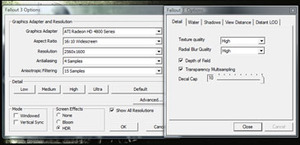Radeon HD 4890 vs GeForce GTX 275
April 3, 2009 | 16:03

Fallout 3
Publisher: BethesdaFallout 3 is the revival of Interplay’s excellent Fallout series of games following many years out of the limelight. It’s developed and published by Bethesda and, judging by the success of the game, we’ll be seeing more Fallout games in the future.
Despite using the Oblivion engine which is now a few years old, the game looks absolutely stunning. Bethesda has spiced up the graphics a bit since Oblivion and has extended the engine – there are some great explosions, soft shadows and smoke effects that are particularly noteworthy.
We tested the game by manually playing a section of the game that incorporates a number of explosions and effects that you’re likely to experience during your time in post-apocalyptic Washington DC. We recorded the frame rate using FRAPS.
The in-game details were set to their highest values and both anti-aliasing and anisotropic filtering were controlled by the application settings instead of through the driver control panel. This meant that transparency anti-aliasing was enabled, along with HDR and all of the cool smoke effects.
Fallout 3’s engine is by default capped to 60 frames per second, which can make benchmark results very unclear, especially when testing at lower resolutions or with high end graphics cards. To remove the 60FPS cap you’ll need to find the Fallout3.ini file in \Documents\My Games\Fallout3 and edit the file so that iPresentInterval=0. This removes the frame rate cap, and allows us to get a much better idea of a card’s abilities.
Fallout 3 bucks the trend set by Crysis, with the Radeon HD 4890 coming out top until we throw 2,560 x 1,600 at it. After this, the HD 4890 crumbles and the GTX 285 claims top spot. It's worth noting that even though the GTX 275 is a touch slower than the HD 4890 in Fallout 3, it's not so much slower that you'd ever care - you wouldn't have to dial down your AA or resolution if you got a GTX 275 rather than a HD 4890.
Also note just how much extra performance you get from the HD 4890 compared with the HD 4870 - the extra 100MHz GPU speed and 300MHz effective memory speed gives a good bit of extra performance. If you have a HD 4870 already, it's definitely worth overclocking it. These tests have also helped to whet our appetite for a spot of overclocking later - what could a 1GHz HD 4890 manage?

MSI MPG Velox 100R Chassis Review
October 14 2021 | 15:04










Want to comment? Please log in.